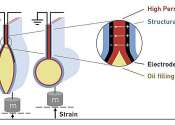Robotic lightning bugs take flight
Fireflies that light up dusky backyards on warm summer evenings use their luminescence for communication—to attract a mate, ward off predators or lure prey.
Jun 21, 2022
0
92
Robotics

Fireflies that light up dusky backyards on warm summer evenings use their luminescence for communication—to attract a mate, ward off predators or lure prey.
Jun 21, 2022
0
92
Robotics

Researchers at Bilkent University in Turkey have recently created a small quadruped robot called SQuad, which is made of soft structural materials. This unique robot, presented in a paper published in IEEE Robotics and Automation ...
Robotics

The sight of a RoboBee careening towards a wall or crashing into a glass box may have once triggered panic in the researchers in the Harvard Microrobotics Laboratory at the Harvard John A. Paulson School of Engineering and ...
Nov 4, 2019
0
291
Robotics

Researchers from North Carolina State University have come up with a new design for thermal actuators, which can be used to create rapid movement in soft robotic devices.
Dec 13, 2021
0
237
Robotics

Researchers at ETH Zurich have recently developed artificial muscles for robot motion. Their solution offers several advantages over previous technologies: It can be used wherever robots need to be soft rather than rigid ...
Jan 30, 2024
1
79
Robotics

A team of researchers at Seoul National University has created a stronger and faster hydrogel actuator by combining turgor design and electro-osmosis. In their paper published in the journal Science, the group describes their ...
Hardware

Researchers in Carnegie Mellon University's Robotics Institute (RI) have designed a system that makes an off-the-shelf quadruped robot nimble enough to walk a narrow balance beam—a feat that is likely the first of its kind.
Apr 17, 2023
0
124
Robotics

Soft robots driven by pressurized fluids could explore new frontiers and interact with delicate objects in ways that traditional rigid robots can't. But building entirely soft robots remains a challenge because many of the ...
Sep 9, 2021
0
77
Engineering

In the field of robotics, researchers are continually looking for the fastest, strongest, most efficient and lowest-cost ways to actuate, or enable, robots to make the movements needed to carry out their intended functions.
Apr 21, 2021
0
66
Engineering

A team of material scientists at the University of Maryland, working with one colleague from Jiaotong University and another from Beihang University, both in China, has developed a cleaner approach to building cooling systems ...
An actuator is a type of motor for moving or controlling a mechanism or system. It is operated by a source of energy, usually in the form of an electric current, hydraulic fluid pressure or pneumatic pressure, and converts that energy into some kind of motion. An actuator is the mechanism by which an agent acts upon an environment. The agent can be either an artificial intelligent agent or any other autonomous being (human, other animal, etc).
This text uses material from Wikipedia, licensed under CC BY-SA